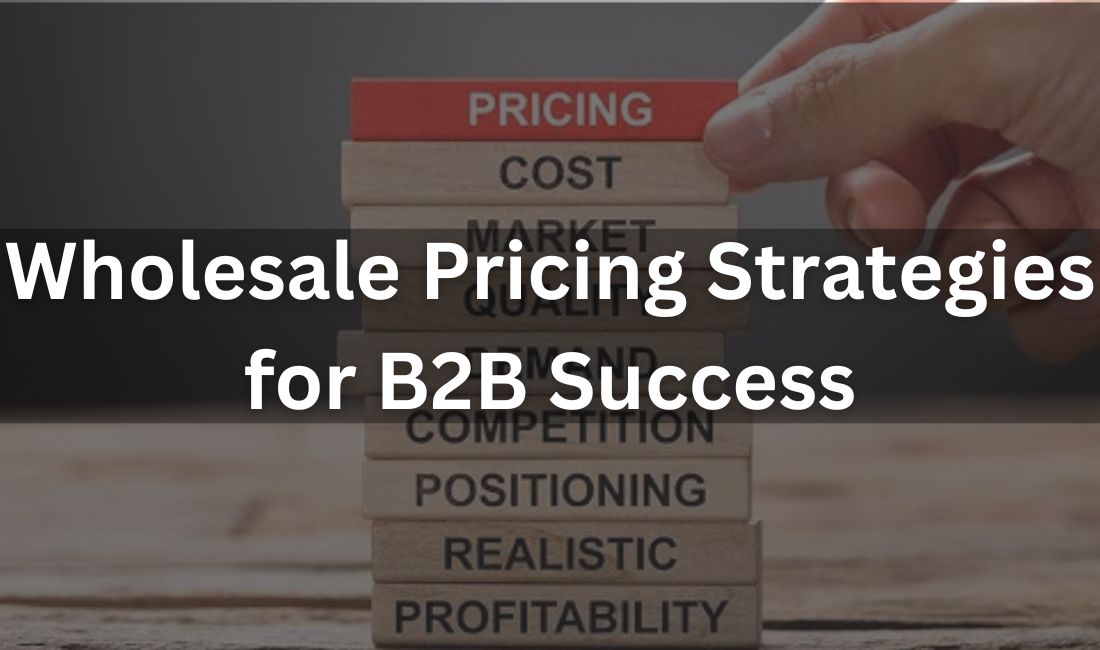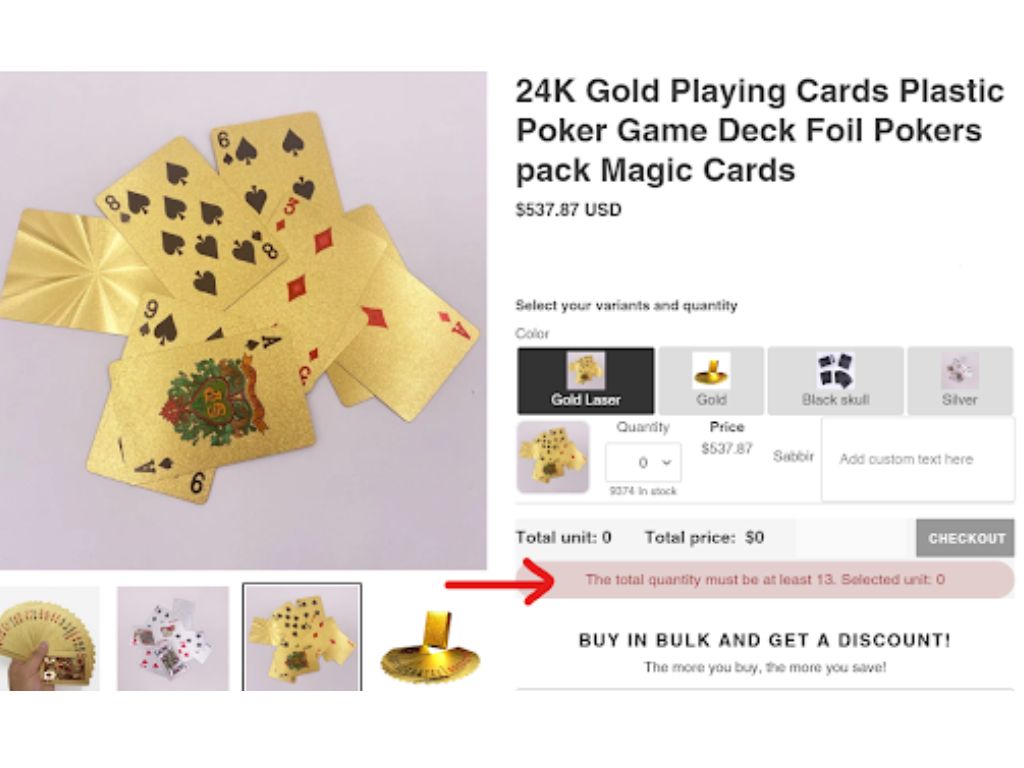
Grand View Research projects USD 25.65 trillion as the global e-commerce B2C market size by 2028. How do you intend to stand out in this very competitive market? Your secret to success may be the appropriate wholesale price!
If you work in wholesale, you should know the need to establish competitive rates. It can boost corporate earnings and draw clients. Learning about the pricing techniques available will enable you to decide which best fits your situation. We go over several wholesale pricing techniques on this page.
Table of Contents
What is Wholesale Pricing?
Wholesale pricing is your game plan for determining the appropriate price for your good or service, most simply. Sometimes referred to as a pricing strategy, choosing the correct one is deliberate rather than merely slapping on a price tag.
Your selected approach immediately affects the impression of your brand among your target market and the income potential. Crucially, you must know which approach fits your company’s objectives and market.
Top 8 Wholesale Pricing Strategies to Use
- Competition-based pricing
- Value-based pricing
- Dynamic pricing
- Cost-plus pricing
- Tiered pricing
- Geographic pricing
- Differentiated pricing
- Absorption pricing
Strategy#1 Competition-Based Pricing
Competition-based pricing schemes are among the most often used in business-to-business. It starts with basing prices somewhat lower or higher on rival pricing. Target market, product quality, and B2B marketing approach—all of which influence price setting—also affect this process.
Competitor-based pricing is usually applied in saturated markets with homogenized products—such as consumer goods, retail, and telecommunications.
Strategy#2 Value-Based Pricing
Businesses in sectors with high degrees of differentiation and demand—such as luxury products, software, and consulting services—will establish prices based on the perceived worth of the product.
Instead of emphasizing manufacturing costs or rival pricing, a value-based pricing approach catches the highest amount a consumer is ready to spend. This is typical of luxury or creative goods.
Strategy#3 Dynamic Pricing
Real-time dynamic pricing is established by algorithms analyzing market demand, competition prices, and other factors, including raw material costs.
A hotel might, for instance, hike rates during the busiest travel season and then cut them off-season. Alternatively, the cost of lumber could affect the price of a custom shed.
Strategy#4 Cost-Plus Pricing
You can determine the final sale price of a product. All you have to do is add a set markup percentage to the cost of the product. It helps ensure that the product generates a profit. You can quickly set a selling price for new products without spending time researching the market and analyzing the competition. However, you must stay aware of market trends and adjust their pricing accordingly to remain competitive.
Strategy#5 Surge Pricing
Surge pricing depends on the product’s demands. When the demand increases, the price increases. The price is low when demand is low.
We can talk about Uber as an example. The ride cost depends on the availability of the drivers. When there aren’t many drivers available, the ride is quite expensive.
It will be helpful for you if your product’s demand isn’t always the same. However, you may face backlash from customers if prices increase too steeply.
Strategy#6 Geographic Pricing
This method lets you charge different pricing for your products or services in various locations. You can adapt to distinct places’ varying demands, constraints, and competitive situations.
It will enable you to increase revenue by charging various prices for the same goods in different regions. Higher fees in high-cost areas will help you manage your costs more effectively.
It can also be complex and challenging. You must first examine each area’s cost, competitive conditions, and demand levels to set proper rates. Be careful to prevent any possible legal or ethical difficulties.
Strategy#7 Differentiated Pricing
Differentiated pricing establishes several rates for the same item based on changing consumer demand, buyer type, and purchase timing. This pricing structure seeks to maximize your ROI. For instance, you might raise your prices to maximize your income in cases of strong demand for products. You can also use differentiated pricing in cases of old goods you wish to get rid of.
Strategy#8 Absorption Pricing
Absorption pricing—also known as complete costing—is the method by which a product’s price incorporates both fixed and variable costs. This considers overhead expenses, including rent and insurance, as well as labor and materials expenditures. Making back your production expenses lets you guarantee a profit margin using absorption pricing.
Pro Tips for Successful Wholesale Pricing
- Understand Your Cost
- Define Target Market
- Tiered Pricing Structure
- Offer Flexible Payment Options
- Set MOQ
- Monitor And Adapt
Tip#1 Understand Your Cost
You must thoroughly understand your costs in and out to create an appropriate wholesale pricing. From manufacturing to delivering the product, you have to calculate and prepare for everything.
Knowing the cost helps you set a profitable price. Otherwise, you can suffer from underpricing or overpricing. Underpricing will lead to losses. Overpricing will lower the product’s competitiveness.
You can manage cash flow and allocate resources effectively if you understand costs. It allows planning for inventory purchases, marketing, and other expenses.
Tip#2 Define Target Market
It guarantees that you’re addressing the needs of the clients directly. Knowing your target market lets you adjust your pricing to meet their needs and budget. This increases the attraction of your offers and aids in establishing enduring relationships and trust with your customers.
Knowing your target market can help you foresee their problems and modify your pricing plan to satisfy their demands while remaining competitive. It all comes down to giving customers the impression that your company is an excellent match for theirs.
Tip#3 Tiered Pricing Structure
Having a tiered pricing structure is a game-changer for your wholesale pricing strategy. It rewards buyers for purchasing more, ultimately boosting your sales volume. Think of it as creating a win-win situation. The more your customers buy, the better their price per unit, and the more you move inventory efficiently. This approach encourages loyalty and lets you cater to a diverse range of clients without alienating smaller buyers. It’s like having a pricing plan that works for everyone while increasing revenue. Plus, it helps you plan production and inventory more effectively.
Tip#4 Offer Flexible Payment Options
It demonstrates your willingness to meet buyers where they are. Every customer’s financial circumstances are different. Some may require more time to make their payments. Others might seize the opportunity for a discount if they pay in advance. Your products become more accessible if you provide options like net 30 terms, staggered payments, or early payment incentives. Closing a sale is not the only goal. It’s about establishing trust and partnerships. Customers are more likely to continue with you and refer you to others when they see that you care about their success. Long-term growth may result from this little step.
Tip#5 Set MOQ
Your order or inventory management procedure will go more smoothly if you use minimum order quantities (MOQs). But it’s important to balance MOQs. Establish a “sweet spot” that is advantageous to both bulk and small purchasers. You can use a bulk order app from the Shopify store to easily set MOQs.

Tip#6 Monitor and Adapt
Keep an eye on your prices and sales numbers over time. The resulting data tells you about the effectiveness of your pricing strategy and lets you know if it’s working or not. You may find sales improve if you increase or decrease the price and if you should discontinue selling something altogether because of low sales.
Pricing Challenges in Wholesale
Misguided pricing leads to lost sales, customer churn, and diminished market share. Here are some common pricing mistakes to avoid
- Making pricing too complicated
- Relying exclusively on undercutting your competition
- Neglecting competitor responses to your price
- Misaligning pricing and business goals
Challenge #1 Making pricing too complicated
B2B businesses can overcomplicate pricing with confusing pricing structures, hidden fees, or inconsistent pricing across channels, which breeds distrust.
While some businesses offer a mixture of pricing models to accommodate customer segmentations (eg: small business versus enterprise), you must reduce complexity for the customer by showing pertinent pricing information.
Custom quote generation is a great way to overcome confusion as customers only pay for what they need.
Challenge #2 Relying exclusively on undercutting your competition
Focusing exclusively on competitors in your pricing strategy can prove detrimental, kicking off a “race to the bottom” price war where businesses slash prices to undercut the competition, driving down profit margins.
Instead, focus on holistic pricing and introducing innovations that bring value to customers.
Challenge #3 Neglecting competitor responses to your price
B2B businesses can’t afford to disregard competitor pricing. Setting prices too high or low leads to lost sales and reduced profitability. Don’t be misled by overconfidence or a lack of market research. Continually monitor competitor pricing to gain an edge in the market.
Challenge #4 Misaligning pricing and business goals
Pricing is intimately linked with business goals because it determines a business’s profit margins and the volume of B2B sales required to break even. While low prices attract customers, the business might not generate sufficient revenue to recover costs.
In luxury markets, low pricing may undermine the business’ reputation.
Businesses should also consider customer needs in setting prices. Offering flexible pricing options like pay-as-you-go or fixed pricing lets customers purchase according to their budget and preferences.
Final Words
Choosing the right pricing strategy can help make your business profitable, allowing you to reliably generate revenue and profits. Pricing models let you determine the best possible price, include pricing buffers so you can raise and lower the price point, and offer satisfactory pricing to your customers. Make sure to go through the different types of pricing strategies to determine which ones apply to your business model and goods or services for the best results.
Wholesale Pricing Strategies FAQ
What is Wholesale Pricing?
Wholesale pricing is the amount a wholesaler charges when selling products to retailers, resellers, or other businesses. It is typically lower than the retail price because it allows the reseller to mark up the price to sell to consumers.
How do You Determine The Right Wholesale Price For Your Products?
To determine the right wholesale price, consider the Cost of Goods Sold (COGS), designed profit margin, market demand, competitor pricing, and any additional costs (such as shipping or packaging). A common approach is to set the wholesale price at 2 to 2.5 times the COGS.
What is The Typical Profit Margin For Wholesalers?
Profit margins for wholesalers vary by industry but typically range from 15% to 50%. The margin depends on factors such as product type, competition, and market demand.
Can You Offer Different Wholesale Prices To Different Buyers?
Yes, wholesalers often offer tiered pricing based on order volume, loyalty, or contractual agreements. Larger orders or long-term partnerships might qualify for discounted pricing.
